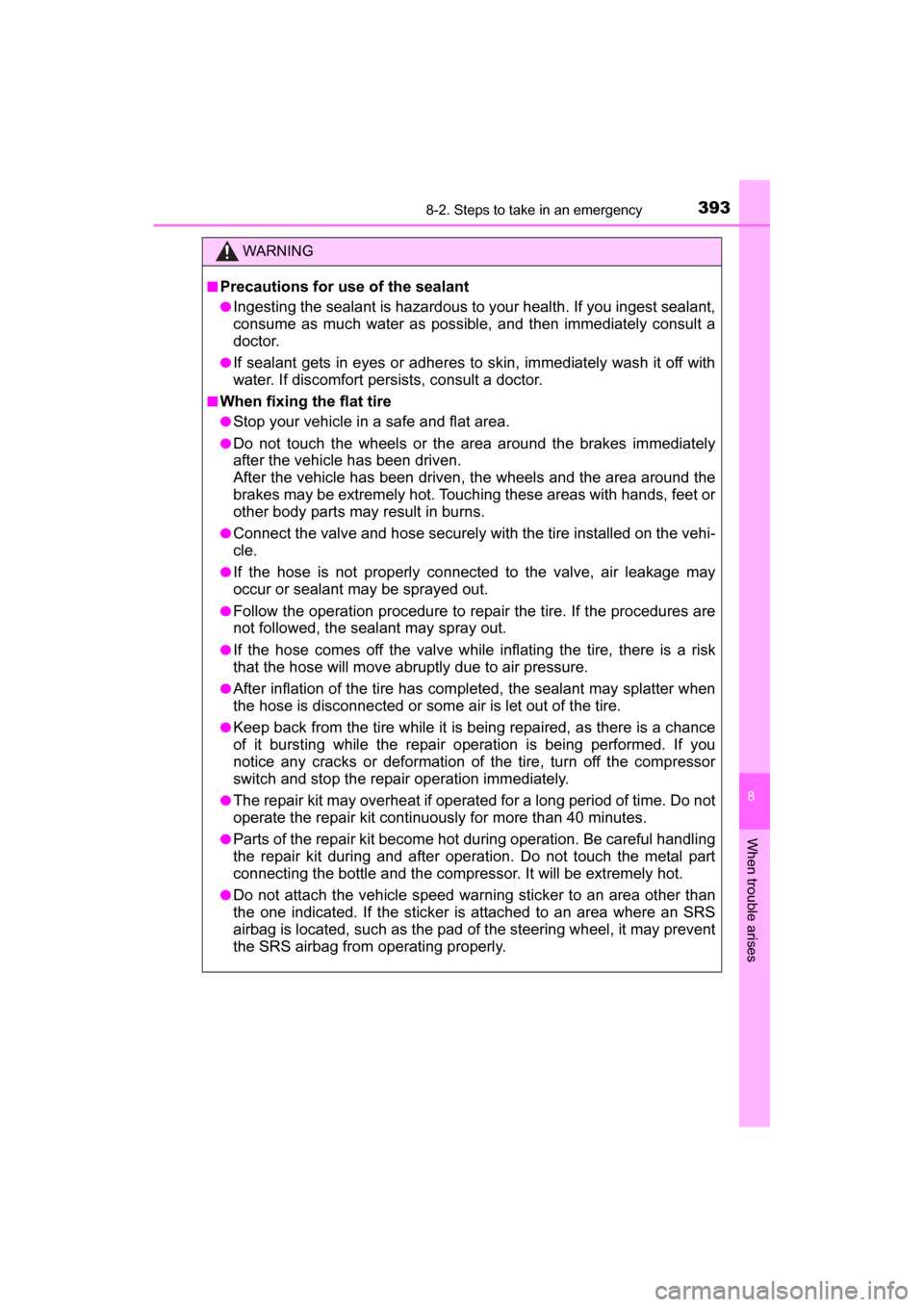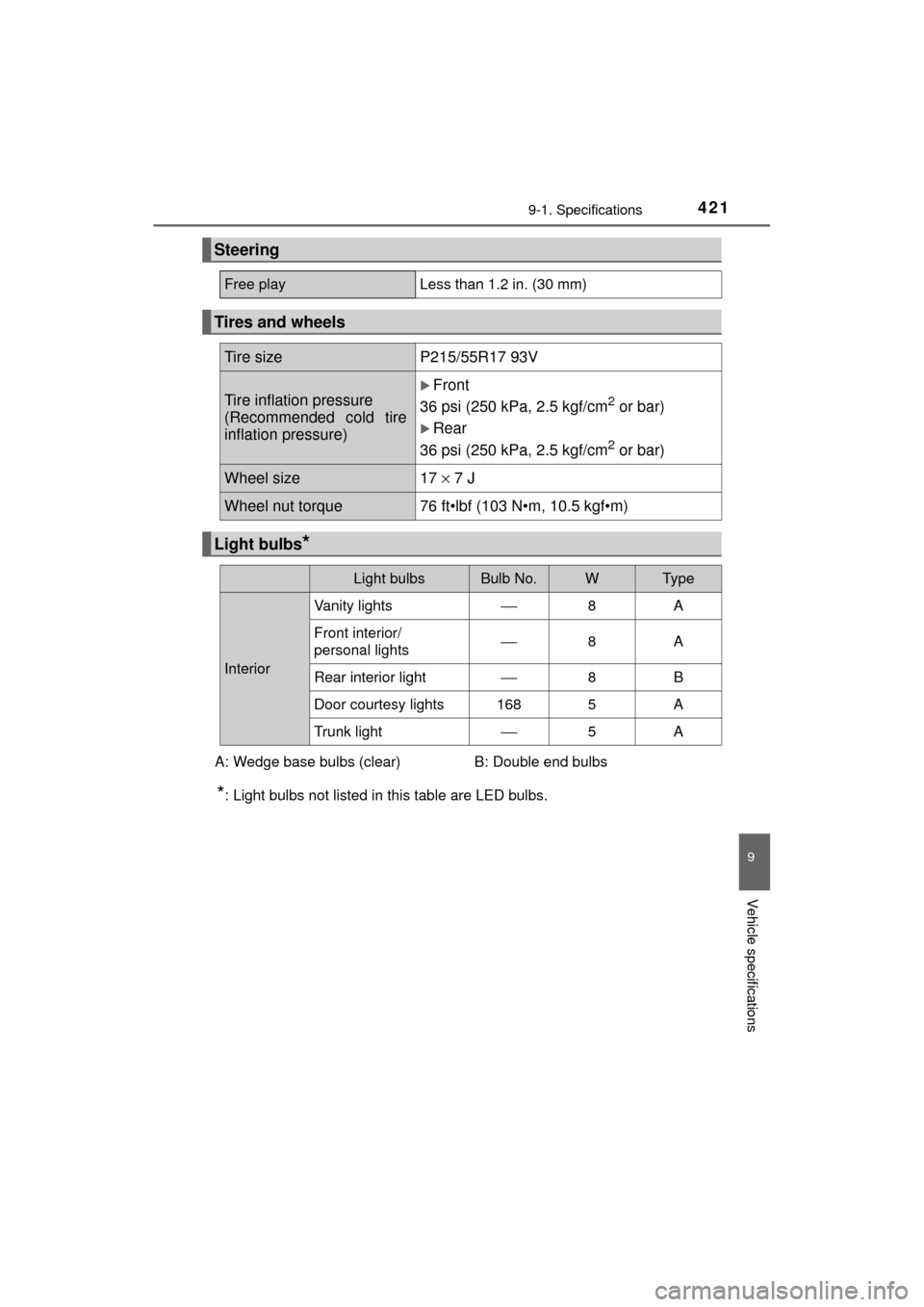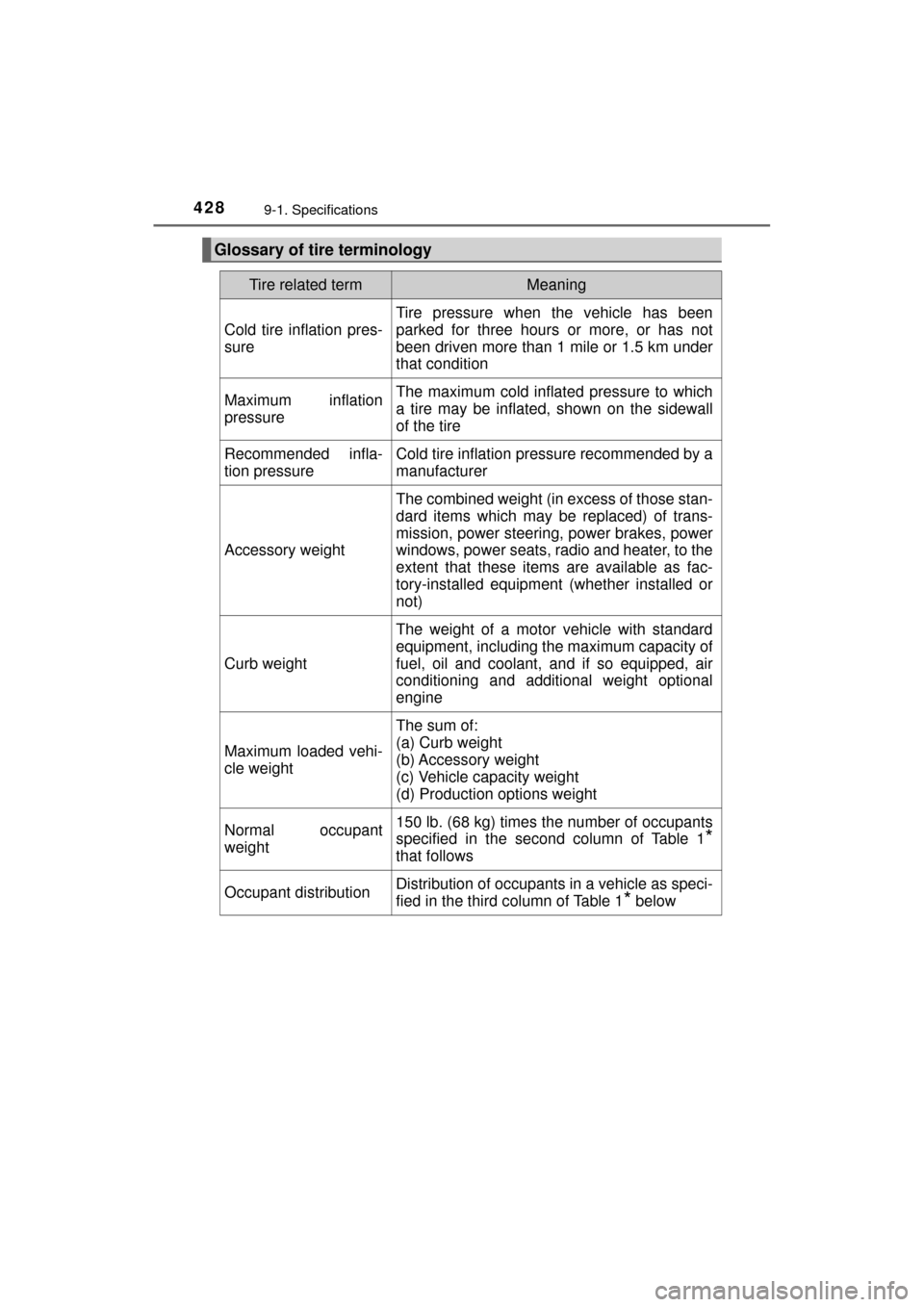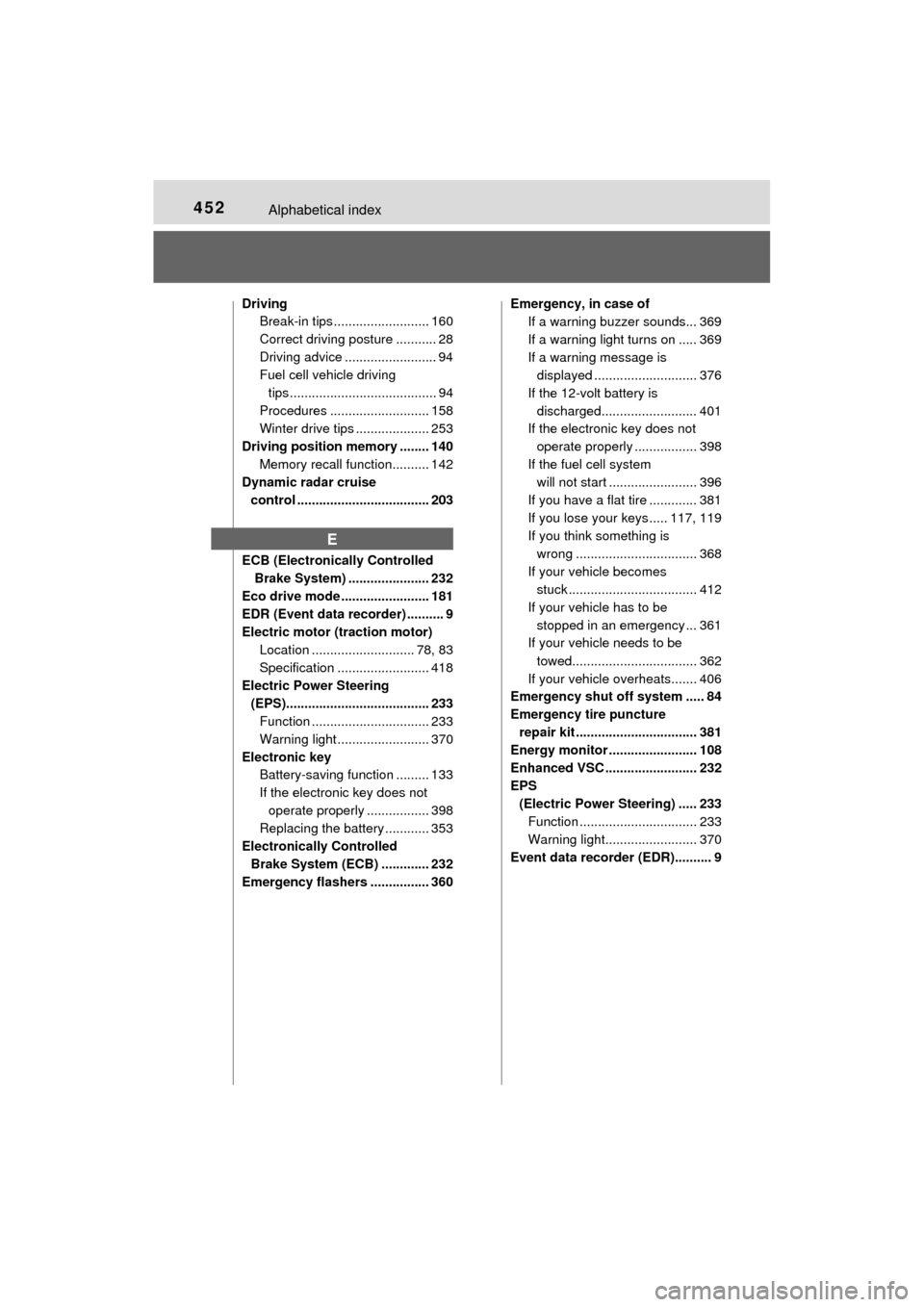2017 TOYOTA MIRAI steering
[x] Cancel search: steeringPage 373 of 464

3738-2. Steps to take in an emergency
MIRAI_OM_USA_OM62023U
8
When trouble arises
■SRS warning light
This warning light system monitors the airbag sensor assembly, front impact
sensors, side impact sensors (front door), side impact sensors (front), side
impact sensors (rear), driver’s seat posit ion sensor, driver’s seat belt buckle
switch, front passenger occupant classification system (ECU and sensors),
“AIR BAG ON” indicator light, “AIR BAG OFF” indicator light, front passen-
ger’s seat belt buckle switch, seat belt pretensioners, airbags, interconnect-
ing wiring and power sources. ( →P. 38)
■ Front passenger detection sensor, seat belt reminder and warning
buzzer
● If luggage is placed on the front passenger seat, the front passenger de\
tec-
tion sensor may cause the warning light to flash and the warning buzzer to
sound even if a passenger is not sitting in the seat.
● If a cushion is placed on the seat, the sensor may not detect a passenger,
and the warning light may not operate properly.
■ Electric power steering system warning light (warning buzzer)
When the 12-volt battery charge becomes insufficient or the voltage tempo-
rarily drops, the electric power steer ing system warning light may come on
and the warning buzzer may sound.
■
When the tire pressure warning light comes on
Inspect the appearance of the tire to check that the tire is not punctured.
If the tire is punctured: → P. 381
If the tire is not punctured:
After turning the power switch to off, turn it to ON mode again and make
sure the tire pressure warning light comes on or blinks.
The tire pressure warning light comes on
After the temperature of the tires have lowered sufficiently, check the
tire inflation pressure and adjust it to the specified level.
If the warning light does not go out even after several minutes, check
that the tire inflation pressu re is at the specified level.
If the warning light does not go out even after several minutes, have the
vehicle inspected by your Toyota dealer immediately.
The tire pressure warning light is blinking for 1 minute, and then comes
on
Malfunction in the tire pressure warning system. Have the system
checked by your Toyota dealer immediately.
■The tire pressure warning light may come on due to natural causes
The tire pressure warning light may come on due to natural causes such
as natural air leaks and tire inflat ion pressure changes caused by tem-
perature. In this case, adjusting the ti re inflation pressure will turn off the
warning light (afte r a few minutes).
■Conditions that the tire pressure warning system may not function
properly
→ P. 3 3 6
1
2
Page 374 of 464

3748-2. Steps to take in an emergency
MIRAI_OM_USA_OM62023U■
Warning buzzer
In some cases, the buzzer may not be heard due to being in a noisy location
or audio sound.
WARNING
■If both the ABS and the brake system warning lights remain on
Stop your vehicle in a safe place immediately and contact your Toyota
dealer. The vehicle will become extremely unstable during braking, and the
ABS system may fail, which could cause an accident resulting in death or
serious injury.
■ When the electric power steering system warning light comes on
When the light comes on yellow, the assist to the power steering is
restricted. When the light comes on red, the assist to the power steering is
lost and handling operations of the steering wheel become extremely
heavy. When steering wheel operations are heavier than usual, grip the
steering wheel firmly and operate it using more force than usual.
■
If the tire pressure warning light comes on
Handling method ( →P. 373)
Be sure to observe the following precautions. Failure to do so could
cause a loss of vehicle control and result in death or serious injury.
●Stop your vehicle in a safe place as soon as possible. Adjust the tire
inflation pressure immediately.
●If the tire pressure warning light co mes on even after tire inflation pres-
sure adjustment, it is probable that you have a flat tire. Check the tires.
If a tire is flat, repair the flat tire by using emergency tire puncture
repair kit.
●Avoid abrupt maneuvering and braking. If the vehicle tires deteriorate,
you could lose control of the steering wheel or the brakes.
■If a blowout or sudden air leakage should occur
The tire pressure warning system may not activate immediately.
Page 393 of 464

3938-2. Steps to take in an emergency
MIRAI_OM_USA_OM62023U
8
When trouble arises
WARNING
■Precautions for use of the sealant
●Ingesting the sealant is hazardous to your health. If you ingest sealant,
consume as much water as possible, and then immediately consult a
doctor.
●If sealant gets in eyes or adheres to skin, immediately wash it off with
water. If discomfort persists, consult a doctor.
■When fixing the flat tire
●Stop your vehicle in a safe and flat area.
●Do not touch the wheels or the area around the brakes immediately
after the vehicle has been driven.
After the vehicle has been driven, the wheels and the area around the
brakes may be extremely hot. Touching these areas with hands, feet or
other body parts may result in burns.
●Connect the valve and hose securely with the tire installed on the vehi-
cle.
●If the hose is not properly connec ted to the valve, air leakage may
occur or sealant ma y be sprayed out.
●Follow the operation procedure to repair the tire. If the procedures are
not followed, the sealant may spray out.
●If the hose comes off the valve while inflating the tire, there is a risk
that the hose will move abru ptly due to air pressure.
●After inflation of the tire has comp leted, the sealant may splatter when
the hose is disconnected or some air is let out of the tire.
●Keep back from the tire while it is being repaired, as there is a chance
of it bursting while the repair op eration is being performed. If you
notice any cracks or deformation of the tire, turn off the compressor
switch and stop the repair operation immediately.
●The repair kit may overheat if operated for a long period of time. Do not
operate the repair kit continuously for more than 40 minutes.
●Parts of the repair kit become hot during operation. Be careful handling
the repair kit during and after operation. Do not touch the metal part
connecting the bottle and the compressor. It will be extremely hot.
●Do not attach the vehicle speed warning sticker to an area other than
the one indicated. If the sticker is attached to an area where an SRS
airbag is located, such as the pad of the steering wheel, it may prevent
the SRS airbag from operating properly.
Page 394 of 464

3948-2. Steps to take in an emergency
MIRAI_OM_USA_OM62023U
WARNING
■Driving to spread the liquid sealant evenly
Observe the following precautions to reduce the risk of accidents.
Failure to do so may result in a loss of vehicle control and cause death
or serious injury.
●Drive the vehicle carefully at a low speed. Be especially careful when
turning and cornering.
●If the vehicle does not drive straight or you feel a pull through the
steering wheel, stop the vehicle and check the following:
• Tire condition. The tire may have separated from the wheel.
• Tire inflation pressure. If tire inflation pressure is 19 psi (130 kPa, 1.3 kgf/cm
2 or bar) or less, this may indicate severe tire damage.
Page 421 of 464

4219-1. Specifications
MIRAI_OM_USA_OM62023U
9
Vehicle specifications
*: Light bulbs not listed in this table are LED bulbs.
Steering
Free playLess than 1.2 in. (30 mm)
Tires and wheels
Tire sizeP215/55R17 93V
Tire inflation pressure
(Recommended cold tire
inflation pressure)
Front
36 psi (250 kPa, 2.5 kgf/cm
2 or bar)
Rear
36 psi (250 kPa, 2.5 kgf/cm2 or bar)
Wheel size 17 × 7 J
Wheel nut torque76 ft•lbf (103 N•m, 10.5 kgf•m)
Light bulbs*
Light bulbsBulb No.WTy p e
Interior Vanity lights
⎯8A
Front interior/
personal lights ⎯
8A
Rear interior light ⎯8B
Door courtesy lights 168 5 A
Trunk light ⎯5A
A: Wedge base bulbs (clear) B: Double end bulbs
Page 428 of 464

4289-1. Specifications
MIRAI_OM_USA_OM62023U
Glossary of tire terminology
Tire related termMeaning
Cold tire inflation pres-
sure
Tire pressure when the vehicle has been
parked for three hours or more, or has not
been driven more than 1 mile or 1.5 km under
that condition
Maximum inflation
pressureThe maximum cold inflated pressure to which
a tire may be inflated, shown on the sidewall
of the tire
Recommended infla-
tion pressureCold tire inflation pressure recommended by a
manufacturer
Accessory weight
The combined weight (in excess of those stan-
dard items which may be replaced) of trans-
mission, power steering, power brakes, power
windows, power seats, radio and heater, to the
extent that these item s are available as fac-
tory-installed equipment (whether installed or
not)
Curb weight
The weight of a motor vehicle with standard
equipment, including the maximum capacity of
fuel, oil and coolant, and if so equipped, air
conditioning and additional weight optional
engine
Maximum loaded vehi-
cle weight
The sum of:
(a) Curb weight
(b) Accessory weight
(c) Vehicle capacity weight
(d) Production options weight
Normal occupant
weight150 lb. (68 kg) times the number of occupants
specified in the second column of Table 1
*
that follows
Occupant distributionDistribution of occupants in a vehicle as speci-
fied in the third column of Table 1
* below
Page 449 of 464

449Alphabetical index
MIRAI_OM_USA_OM62023U
Alphabetical index
A/C ............................................ 258Air conditioning filter ............. 351
Automatic air conditioning
system ......... ....................... 258
ABS
(Anti-lock Brake System)...... 232 Function ................................ 232
Warning light ......................... 370
Air conditioning filter .............. 351
Air conditioning system .................................... 258
Air conditioning filter ............. 351
Airbags ....................................... 36 Airbag operating conditions .... 44
Airbag precautions for
your child .............................. 39
Airbag warning light .............. 370
Correct driving posture ........... 28
Curtain shield airbag operating conditions ............. 45
Curtain shield airbag precautions ........................... 42
Front passenger occupant
classification syst em............. 49
General airbag precautions .... 39
Locations of airbags................ 36
Modification and disposal of airbags ............... 43
Seat cushion airbag ................ 36
Side airbag operating conditions ............................. 45
Side airbag precautions .......... 41
Side and curtain shield airbags operating conditions ............. 45
Side and curtain shield airbags precautions ........................... 42
SRS airbags............................ 36 Alarm .......................................... 74
Anchor brackets ........................ 69
Antennas
(smart key system) ............... 131
Anti-lock Brake System
(ABS) ...................................... 232 Function ................................ 232
Warning light......................... 370
Armrest..................................... 281
Assist grips .............................. 282
Audio input
*
Audio system*
Steering wheel audio switch*
Automatic air conditioning system.................................... 258 Air conditioning filter ............. 351
Automatic headlight leveling
system.................................... 189
Automatic High Beam ............. 190
Automatic light control system.................................... 187
AUX port
*
Auxiliary box ............................ 276
A
*: Refer to the “NAVIGATION SYSTEM OWNER’S MANUAL”.
Page 452 of 464

452Alphabetical index
MIRAI_OM_USA_OM62023U
DrivingBreak-in tips .......................... 160
Correct driving posture ........... 28
Driving advice ......................... 94
Fuel cell vehicle driving
tips ........................................ 94
Procedures ........................... 158
Winter drive tips .................... 253
Driving position memory ........ 140 Memory recall function.......... 142
Dynamic radar cruise
control .................................... 203
ECB (Electronically Controlled Brake System) ...................... 232
Eco drive mode ........................ 181
EDR (Event data recorder) .......... 9
Electric motor (traction motor) Location ............................ 78, 83
Specification ......................... 418
Electric Power Steering (EPS)....................................... 233
Function ................................ 233
Warning light ......................... 370
Electronic key Battery-saving function ......... 133
If the electronic key does not
operate properly ................. 398
Replacing the battery ............ 353
Electronically Controlled Brake System (ECB) ............. 232
Emergency flashers ................ 360 Emergency, in case of
If a warning buzzer sounds... 369
If a warning light turns on ..... 369
If a warning message is displayed ............................ 376
If the 12-volt battery is discharged.......................... 401
If the electronic key does not
operate properly ................. 398
If the fuel cell system will not start ........................ 396
If you have a flat tire ............. 381
If you lose your keys ..... 117, 119
If you think something is wrong ................................. 368
If your vehicle becomes stuck ................................... 412
If your vehicle has to be stopped in an emergency ... 361
If your vehicle needs to be
towed.................................. 362
If your vehicle overheats....... 406
Emergency shut off system ..... 84
Emergency tire puncture
repair kit ................................. 381
Energy monitor ........................ 108
Enhanced VSC ......................... 232
EPS (Electric Power Steering) ..... 233 Function ................................ 233
Warning light......................... 370
Event data recorder (EDR).......... 9
E